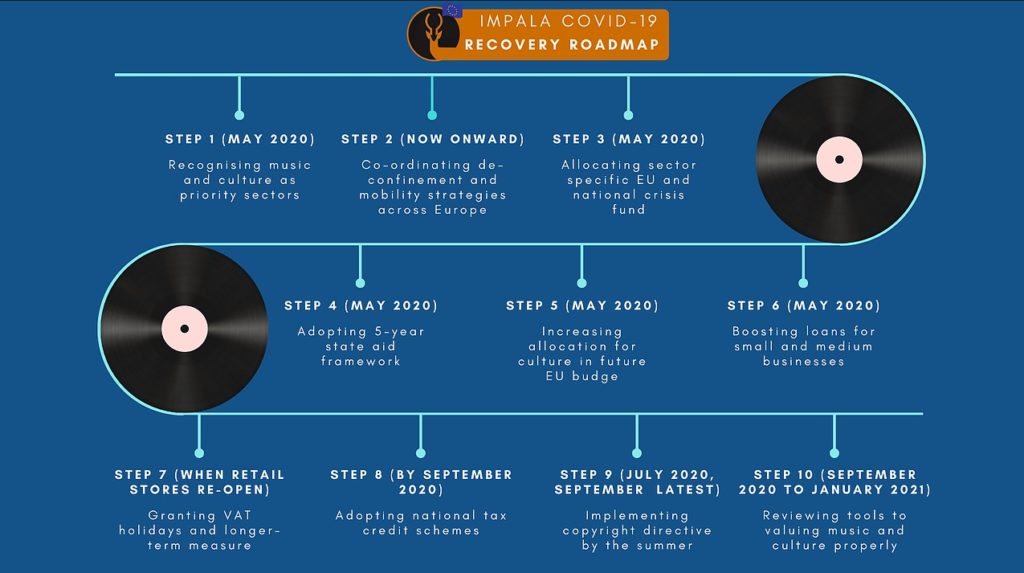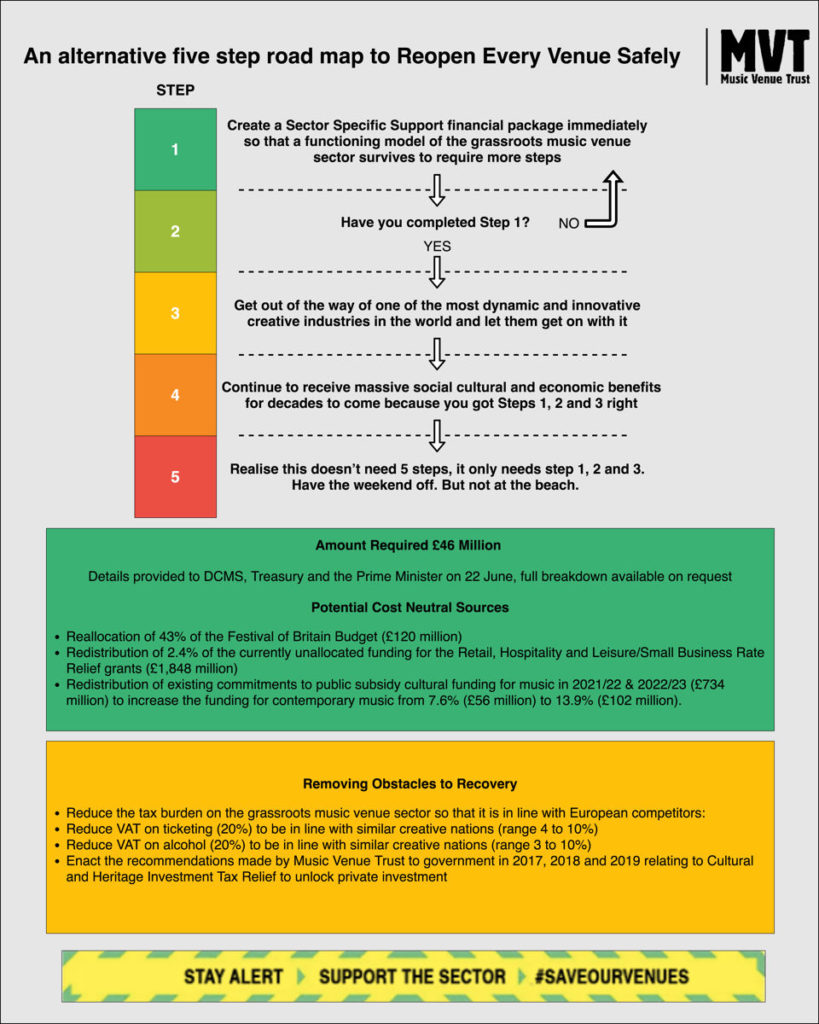Last update: 29/06/2020 – 14:00
This article presents the different exit strategies for the live music sector in the countries part of the Live DMA network as well as the reactions of our members.
EU
World Health Organisation
On the 29th of May 2020, the World Health Organisation released Key planning recommendations for mass gatherings in the context of the current COVID-19 outbreak. This document presents recommendations to hold mass gathering events and underlines the social and cultural benefits of holding such events.
>> Access the document here (in English)
European Commission
The European Commission released a set of guidelines: the Joint European Roadmap Towards Lifting COVID-19 Containment Measures (April 2020).
>> Access it here
>> Access here an article on IQ Mag synthetizing the EU Commission’s guidelines, notably emphasizing the impact for live music scenes. “EU: Festivals, concerts to be last to reopen” – IQ Mag – 21/04/2020
IMPALA 10 Steps Recovery Plan
IMPALA proposed a recovery roadmap to boost growth in Europe through music and culture, in sync with the EU Recovery Plan, as follows:

“Europe and its member states need an ambitious 5-year recovery strategy
post-coronavirus crisis to boost investment, jobs and growth. Only a
multi-annual approach focussing on key sectors will allow for a proper
European recovery in the long term. IMPALA proposes a ten-step
roadmap with a timeline requiring decisions in May through to September
and beyond.”
Step 1 – Recognising music and culture as priority sectors (May 2020)
Step 2 – Co-ordinating de-confinement and mobility strategies across Europe (now onwards)
Step 3 – Allocating sector specific EU and national crisis funds (May 2020)
Step 4 – Adopting 5-year state aid framework (May 2020)
Step 5 – Increasing allocation for culture in future EU budget (May 2020)
Step 6 – Boosting loans for small and medium businesses (May 2020)
Step 7 – Granting VAT holidays and longer-term measures (when retail stores re-open)
Step 8 – Adopting national tax credit schemes (by September 2020)
Step 9 – Implementing EU copyright directive by the summer (July 2020, September latest)
Step 10 – Reviewing tools to value music and culture properly (September 2020 to January 2021)
>> More information on IMPALA’s 10 steps recovery plan here.
PEARLE* – Map of Reopenings of Live Music Scenes in Europe
PEARLE* have released a map showing the status of closure or reopening of live music scenes in European countries.
>> Access the map here.
European Parliament
The European Parliamentary Research Service have released a document entitled Performing Arts: Emerging from Confinement.
“In the EU as elsewhere in the world, the performing arts were among the first sectors to be hit by measures to slow the spread of the coronavirus, and are now among the last to reopen. As the confinement measures are relaxed, the focus now is on supporting the performing arts and finding a way to re-engage with live audiences.”
Belgium (WB)
In Belgium, events are forbidden until 31st of August 2020.
Court-Circuit released an article entitled “Everyone on the same boat: the Belgian music scenes thinks about the post-confinement” reflecting on the challenges live music scenes will face when opening again. Challenges include:
- The uncertainty of the sanitary conditions venues will have to comply with
- The competition that will arise in Autumn because of a saturated concert offer due to postponements of Spring and Summer events
- The uncertainty regarding the reaction and possible change of habits of the audience
Yet, Court-Circuits stays hopeful: the sector is used to finding creative solutions to problems, and the solidarity of the actors of the music sector will participate in minimizing the risks for the venues.
Italy
On the 17th of May, the Italian government released an exit plan for the Italian event sector. From the 15th of June:
- events up to 200 people for indoor events and of 1000 people for outdoor events will be able to take place;
- physical distanciation of 1 meter shall be respected;
- water and food sales will be forbidden on the event area.
KeepOn Live has raised its voice against the unfeasability and unsustainability of such measures for the live music sector, pointing out the sale of food and drinks is a huge part of the clubs’ income, or the difficulty for live music organisers to obtain sponsoring for an event that will be economically unsustainable, and call for the text to be amended:
“It is paradoxical and sometimes ridiculous the possibility allowed to realize the events (putting into practice all the necessary limitations), making it impossible to realize them both from the point of view of public health and safety.
There is, moreover, the further risk that due to excessive and irrational regulations the public could lose the desire to participate in the events, delaying in fact the return to normality that we all desire. We are therefore confident that the now famous Annex 9 can be amended, before 15 June, so that we can talk about a real restart, albeit minimal, but at least sustainable.”
[Translated with DeepL Translator]
>> read the Italian government’s exit plan – Art. 1m (in Italian)
>> read KeepOn Live’s reaction here (in Italian)
Norway
In Norway, from May 7th, events up to 50 people will be able to take place. From June 15th, events up to 200 people can take place.
In their reaction to the exit strategy proposed by the Norwegian authorities, NKA declare that such a plan could provide room for the smallest organizers, but is not enough for the music industry to start again.
“Initially, it is positive that there are now clear signs that society can gradually be re-opened. At the same time, it is long until we can be together as we usually do. Our industry was among the very first to be shut down, and will most likely be among the very last to open completely. In the meantime, the focus must be to keep the organizers and the rest of the players in the music field afloat. For some of the smallest, an opening for events with up to 200 people could represent such an opportunity, and I think we will see many positive initiatives going forward. At the same time, we should not underestimate what maintaining the infection control rules will require of the organizers. And for the larger industry players, events for up to 200 people will not be close to being financially sound […] Both the music freedom and the music industry players have been clear that the government’s crisis packages do not cover the music scene well enough. Norwegian Concert Organizers are concerned about the need to establish long-term and effective compensation schemes. It is an unsustainable situation that we do not know anything about how actors that are closed down by the authorities should be financially compensated, and in this picture, events for up to 50 people help little by little. We are continuing to work to get the authorities to understand the seriousness of our industry.” – Tone Østerdal, CEO, NKA
[Translated with Google Translate]
>> read the full article (in Norwegian)
NKA have released guidelines listing the sanitary requirements for the reopening of venues and a poster with useful tips for artists, audience and organisers for events that will take place during the re-opening period.
>> Access the guidelines and poster here (both in Norwegian)
Spain
The exit plan laid out by Spanish Prime Minister sees the country reopening in four stages, starting from 11th May. Each phase will have a duration of two weeks as a minimum. The situation in each province of the country will be re-evaluated before the implementation of the next stage of the plan, with different regions of the country possibly proceeding at different speeds.
In phase one – beginning on 11 May – “cultural events” will be allowed to start again, with a maximum capacity of 30 people for indoor venues that usually have a capacity of 90 or more, and of 200 for open-air events. All outdoor events must be seated, with the condition of social distancing rules.
In phase two, which could begin as early as 25 May, indoor concerts will reopen at a third of their usual capacity, with a maximum capacity of 50 people. Seated, open-air events will be permitted for up to 400 people, with all punters maintaining the “necessary distance”.
The final, “advanced” stage of the plan, set to start from 8 June, sees the reopening of night clubs and bars at a third of usual capacity. Indoor events will have a capacity limit of 80, still operating at 33% of normal size, and outdoor events of up to 800 people will be allowed.
Representatives from the Spanish live industry, including ACCES, ASACC and Kultura Live have said that enforcing a capacity reduction for venues following their reopening would be “unsustainable”.
UK
REVS (Reopen Every Venue Safely) Initiative Launches with US Pilots and Complementary UK and Canadian Tracks
REVS is an international initiative aimed at promoting best practices, work plans and protocols to ensure music venues are able to open as quickly and safely as possible.
REVS is a campaign to develop and disseminate action plans and budgets rooted in a hyper-pragmatic understanding of the challenges ahead.
Music Venue Trust cofounder Mark Davyd said “in this moment of crises for venues it is all hands on deck. We look forward to sharing strategies with our colleagues in the US and Canada to learn how we best manage this unprecedented challenge as a community.”
REVS is a project of Music Cities Together. Interested parties can sign up for the REVS mailing list at https://form.jotform.com/201256984278061 or contact REVSinformation@gmail.com.
On the 26th of June 2020, as the UK government has unveiled its re-opening plan for the live sector, Music Venue Trust replied back with their 5 steps REVS plan.

>> Find a detailed article explaining the situation here.
